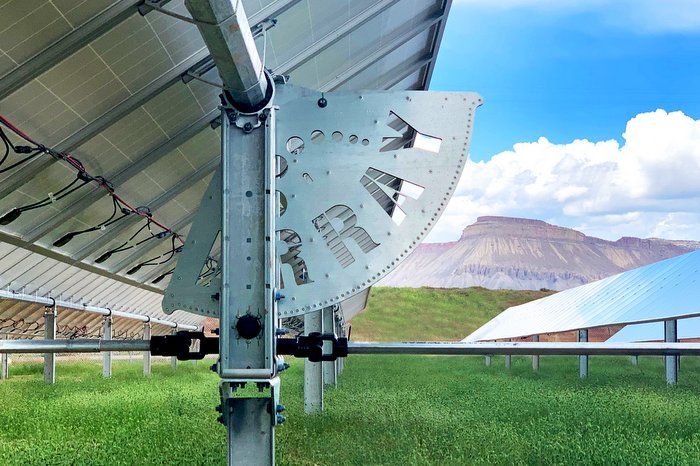Details on 11 new MOSAIC solar technologies that will receive government funding
High Direct Normal Incident (DNI) Solar Radiation Technologies
Panasonic Boston Laboratory – Newton, Mass. Low Profile CPV Panel with Sun Tracking for Rooftop Installation – $2.1 million. Panasonic Boston Laboratory (PBL) will develop two micro-tracking systems that allow solar panels to orient direct sunlight onto micro-PV cells without a conventional tracking system. The first tracking system includes two arrays of laterally moving optics – an upper array of focusing lens, and a lower array of optical elements, PV cells, and an electrical interconnect. As the sun moves throughout the day, the position of the optics relative to the PV cells shifts to keep the sunlight focused on the cells.
In its second system, the full optical array rotates in order to orient solar radiation onto the PV cells as the sun moves. This rotation occurs in two movements – rows of lenslets, which make up the lens array, tilt about their long axis, and a second axis rotates the array to ensure the lens’ optical axis is parallel to the sun. By eliminating the need for an expensive tracking system, PBL’s technologies could realize the benefits of CPV for rooftop applications in areas with high direct sunlight. These projects have been selected for negotiation of awards; final award amounts may vary.
Pennsylvania State University – University Park, Pa. Wide-Angle Planar Microtracking Microcell CPV – $2.9 million. Researchers at The Pennsylvania State University and their partners will combine optical concentrators, micro-PV cells and a novel tracking system to produce fixed-tilt CPV panels. The team will use a combination of refractive and reflective plastic lens let arrays to concentrate sunlight onto a corresponding array of micro-PV cells, which will be transfer-printed onto a transparent sheet that slides between them. Tracking will be accomplished by incrementally moving the middle microcell sheet laterally as the sun shifts, allowing the system to operate throughout the entire day without tilting the panel. High-throughput printing techniques will help reduce the cost to manufacture the microcell array, and will also allow the team to create five junction microcells, which will boost the conversion efficiency of the cells.
University of Rochester – Rochester, N.Y. Planar Light Guide Concentrated Photovoltaics – $1.5 million. University of Rochester researchers and their partners will develop its planar light guide system using micro-optics to capture, orient and concentrate direct sunlight onto a single PV cell, located on the edge of a module. By guiding sunlight to a single cell, the system reduces the complexity inherent in a module that includes arrays of thousands of micro-PV cells.
The team’s system will be very thin (less than 3 mm thick) and lighter than conventional CPV panels. Its light weight will help reduce the cost and size of trackers and framing materials needed to pivot the system towards direct sunlight. This innovation could allow the technology to be used on rooftops in space-constrained urban areas. The team will also develop a scalable fabrication technique that uses grayscale lithography to produce the micro-optics.
Low Direct Normal Incident (DNI) Solar Radiation Technologies
California Institute of Technology – Pasadena, Calif. Micro-Optical Tandem Luminescent Solar Concentrator – $3 million. Researchers at the California Institute of Technology and their partners will design and fabricate a new CPV module, which includes multiple concentrator features that allow the product to be used in regions with low amounts of direct sunlight. The team’s luminescent solar concentrator sheet includes quantum dots that convert the high-energy spectrum of light into appropriate wavelengths for wide bandgap microPV cells. The sheet is coated with advanced materials that act as highly reflective filters, enhancing the concentration of sunlight onto the cells.
Additionally, a low-bandgap tandem solar cell beneath the sheet will capture the lower energy portions of the spectrum not absorbed by the quantum dots. By limiting the density of the micro-PV cells within the concentrator sheet, the project team will reduce system costs, but still enable high performance. Due to the concentrator’s effectiveness at collecting and converting diffuse light with the micro-PV cells, the technology does not require a tracking system and therefore could be installed in any PV installation, including space-constrained rooftops.
Massachusetts Institute of Technology – Cambridge, Mass. Integrated Micro-Optical Concentrator Photovoltaics with Lateral Multi-junction Cells – $3.5 million. Massachusetts Institute of Technology and its partner will develop flat-panel PV modules that integrate a micro-optical system, allowing solar cells to efficiently capture energy from both direct and diffuse sunlight. The team’s micro-optical lens system will be ultra-compact and highly efficient, quadrupling the concentration of direct sunlight and tripling and the concentration of diffuse sunlight. This optics system will act as a prism to split the solar spectrum into different wavelengths, which will then be collected by laterally arranged solar cells appropriate to each wavelength.
Conventional PV cells will be integrated beneath this array to capture diffuse sunlight. To reduce costs, the team’s lens system will utilize materials that can be affordably manufactured into large-area roll-to-roll optical sheets.
Massachusetts Institute of Technology – Wafer-Level Integrated Concentrating Photovoltaics – $1.2 million. Massachusetts Institute of Technology and its partner will develop a micro-PV approach that uses common PV cells as part of its concentrator architecture, which reduces the complexity of the system’s tracking needs. The team’s key innovation is the use of a common silicon-PV cell for more than one function. Notably, the PV cell will function as part of the optical platform, integrating wafer-level micro-concentrators to significantly enhance sunlight concentration onto arrays of high-performance micro-PV cells. The PV cell will also function as a diffuse solar radiation collector, allowing the technology to operate in regions with high levels of diffuse sunlight. The team will use standard semiconductor processes to fabricate the system, ensuring high-precision, yet low-cost manufacturing.
Semprius, Inc. – Durham, N.C. Micro-Scale Ultra-High Efficiency CPV/Diffuse Hybrid Arrays Using Transfer Printing – $2.9 million. Semprius and its partners will design a CPV module that integrates two types of solar cells in order to efficiently capture diffuse and direct sunlight. The team will create six-junction PV cells that exceed the efficiency of even the highest performing PV cells on the market today. Arrays of these six-junction PV cells will convert direct sunlight to electricity, while low-cost single-junction solar cells will efficiently convert diffuse sunlight. Semprius will use its expertise in cost-effective micro-transfer printing to fabricate and assemble the six-junction microcells. In addition to the cost benefits of micro-transfer printing, the team will utilize less expensive optics to reduce the cost of the system. By integrating cells that capture diffuse sunlight, Semprius’ innovation could expand the use of high-efficiency CPV in regions with low direct sunlight.
Sharp Laboratories of America – Camas, Wash. A High-Efficiency Flat Plate PV with Integrated Micro-PV atop a 1-Sun Panel – $2.7 million. Sharp Laboratories of America and its partner will develop a flat PV panel that integrates high-efficiency micro-PV cells with 1-sun solar panels in order to capture diffuse and direct sunlight. The team’s innovation will feature an array of advanced lenses to capture and concentrate direct sunlight onto a waveguide, which then further concentrates the light onto micro-PV cells. These optics demonstrate low losses in comparison to conventional two-dimensional lenslet arrays. Attached beneath the micro-PV cells, a bifacial 1-sun panel collects diffuse sunlight from the sky and the ground, further amplifying the system’s efficiency. To allow for optimal collection of sunlight throughout the day, the system will be mounted on a two-axis tracker.
Texas A&M University Engineering Experiment Station – College Station, TX Waveguiding Solar Concentrator – $991,898. Researchers at Texas A&M University’s Engineering Experiment Station will create a novel optical architecture for concentrated solar systems that increases the solar-to-electric efficiency in flat PV panels. To significantly increase concentration of sunlight onto the PV cells, the team will arrange the concentrating lens arrays in a cascading fashion and align the arrays to a secondary concentrator using tapered waveguides. The waveguide concentrators, which are similar in performance to lens or other imaging optics, will enable the multi-junction solar cells to efficiently convert diffuse sunlight, enabling the system to be used in less sunny regions. The team will use low-cost glass and polymer materials to help minimize costs.
Partial Solutions
Palo Alto Research Center – Palo Alto, CA Micro-Chiplet Printer for MOSAIC – $1.5 million. The Palo Alto Research Center (PARC) will design and build a micro-PV cell (or chiplet) prototype printer with the potential to enable economical, high-volume manufacturing of micro-PV cell arrays. Leveraging its expertise in digital xerographic assembly, PARC will create a printer demonstration that uses ink composed of micro-PV cells to digitally place and electrically interconnect micro-PV cells. The printer will arrange the cells in a predefined, precise fashion. To demonstrate the effectiveness of the printer, the project team will investigate two types of backplanes (electrically connected PV arrays arranged on a surface): one with a single type of micro-PV cell, and one with at least two types of micro-PV cells.
Small Business Innovation Research (SBIR)
Glint Photonics, Inc. – Burlingame, Calif. Stationary Wide-Angle Concentrator PV System – $1.7 million. Glint Photonics, Inc. and its partner will design a novel CPV system that eliminates the need for bulky, expensive tracking and control systems and enables CPV to be installed on rooftops. Instead of using a fixed, mechanical tracking system to continuously focus sunlight onto the micro-CPV cells, the project team will develop a stationary system that automatically moves a sheet of receivers within the panel. In order to shift the sheet toward the sun’s light, the system will use a fluidic suspension mechanism that permits frictionless movement and a novel drive process that consumes a small fraction of the sun’s energy to ensure the sheet remains aligned. The project team will use four-junction micro-PV cells that significantly increase the system’s solar-to-electric energy conversion.




